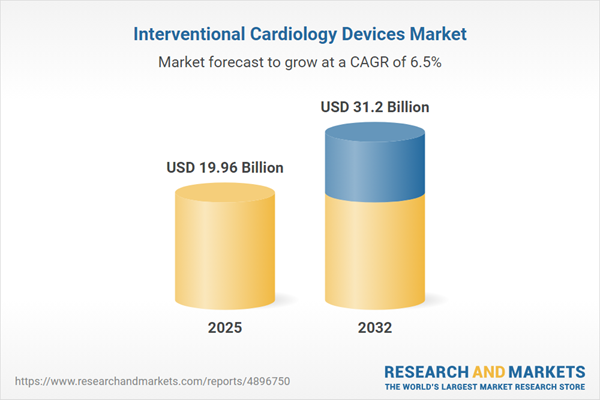Speak directly to the analyst to clarify any post sales queries you may have.
The interventional cardiology devices market is evolving rapidly, reshaping how healthcare systems address complex cardiovascular conditions. Senior leaders navigating this landscape must understand not only technological advances but also the regulatory and economic shifts that influence procurement and long-term strategy.
Market Snapshot: Interventional Cardiology Devices Market Growth and Trends
The interventional cardiology devices market grew from USD 18.78 billion in 2024 to USD 19.96 billion in 2025. It is projected to advance at a CAGR of 6.54%, reaching USD 31.20 billion by 2032. This expansion is fueled by the adoption of minimally invasive procedures, significant improvements in device design and imaging technologies, and a broadening demand from aging populations requiring tailored cardiovascular solutions. Strategic investments by both established and emerging players drove increased innovation, even as economic pressures influenced buying patterns among providers worldwide.
Scope & Segmentation of the Interventional Cardiology Devices Market
This report delivers a comprehensive analysis of market structure, technology adoption, and regional trends, offering in-depth segmentation for actionable decision-making. Key segmentations include:
- Device Types: Catheters (aspiration, balloon—including over-the-wire and rapid-exchange, guiding), closure devices (active, passive), guidewires (diagnostic, interventional), IVUS and imaging systems, stents (bare metal, biodegradable, drug-eluting), and thrombectomy devices.
- Material Types: Metals such as cobalt-chromium and platinum-chromium, alongside polymers for increased flexibility and biocompatibility.
- Technology: Balloon angioplasty, echocardiography, laser-based imaging, and pyrolytic carbon enhancements for improved device function and longevity.
- Applications: Angiographic interventions (neurovascular and peripheral angioplasty), coronary procedures (angioplasty and percutaneous coronary intervention), and valve or structural heart interventions (transcatheter repair and replacement).
- End Users: Ambulatory surgical centers, cardiac specialty centers, hospitals and clinics, and research institutes focusing on clinical trials and innovation.
- Geographic Regions: Americas (North and Latin America), Europe, Middle East & Africa (with detailed country-level insight), and Asia-Pacific nations such as China, India, Japan, and others.
Key Takeaways for Senior Decision-Makers
- Technological convergence is driving new standards in device performance, safety, and integration with digital health platforms, enhancing both care delivery and operational workflow.
- There is intensifying focus on value-based procurement, with hospitals and clinics aligning purchasing with patient outcomes as reimbursement pressures increase.
- Supply chain resilience has become crucial due to shifting trade policies, requiring diversification and investment in regionalized manufacturing.
- Collaboration between clinicians, engineers, and regulatory bodies is shaping faster product approvals and facilitating agile responses to emerging clinical needs.
- Companies are forming strategic partnerships to expand market presence and develop AI-enabled devices, capturing evolving demand and new use cases.
- Regional distinctions influence market entry and commercialization strategies, with regulatory environments, local production incentives, and demographic trends all playing key roles.
Tariff Impact: US Policy and Global Supply Chain Implications
Forthcoming tariffs on US medical device imports in 2025 are set to impact landed costs, procurement budgets, and supply strategies across the sector. Firms reliant on international sourcing must reassess manufacturing footprints and may accelerate regional investments to offset trade disruptions. Providers are expected to increase value-based tendering and carefully evaluate alternatives as device costs and supply chain considerations evolve.
Methodology & Data Sources
This analysis integrates primary interviews with cardiologists, device engineers, and procurement experts, and is supported by secondary research from leading journals, regulatory data, and company reports. Rigorous data triangulation ensures findings reflect both market realities and stakeholder perspectives.
Why This Report Matters
- Enables evidence-based planning by quantifying and contextualizing emerging opportunities in segmentation, technology adoption, and end user priorities.
- Supports risk mitigation through forward-looking insights into tariff-related challenges and supply chain strategy.
- Informs investment and partnership decisions by mapping competitive dynamics and regulatory changes shaping market access.
Conclusion
With a robust combination of technology, regulatory shifts, and regional growth drivers, the interventional cardiology devices market presents multiple strategic opportunities. Timely, granular insights from this report position executive teams to lead confidently through change and innovation.
Additional Product Information:
- Purchase of this report includes 1 year online access with quarterly updates.
- This report can be updated on request. Please contact our Customer Experience team using the Ask a Question widget on our website.
Table of Contents
3. Executive Summary
4. Market Overview
7. Cumulative Impact of Artificial Intelligence 2025
Companies Mentioned
The companies profiled in this Interventional Cardiology Devices market report include:- Abbott Laboratories
- AngioDynamics, Inc.
- B. Braun Melsungen AG
- Becton, Dickinson and Company
- Biosense Webster, Inc. by Johnson & Johnson Services, Inc.
- Biosensors International Group, Ltd.
- Biotronik SE & Co. KG
- Boston Scientific Corporation
- Cardinal Health, Inc.
- Cook Medical Inc.
- Cordis Corporation by Cardinal Health company
- Edward Lifesciences Corporation
- Endologix, Inc.
- GE HealthCare Technologies Inc.
- iVascular SLU
- Lepu Medical Technology (Beijing) Co., Ltd.
- Medtronic plc
- Merit Medical Systems, Inc.
- Siemens Healthineers AG
- Teleflex Incorporated
- Terumo Corporation
- Volcano Corporation by Philips Holding USA Inc.
Table Information
| Report Attribute | Details |
|---|---|
| No. of Pages | 185 |
| Published | November 2025 |
| Forecast Period | 2025 - 2032 |
| Estimated Market Value ( USD | $ 19.96 Billion |
| Forecasted Market Value ( USD | $ 31.2 Billion |
| Compound Annual Growth Rate | 6.5% |
| Regions Covered | Global |
| No. of Companies Mentioned | 23 |









